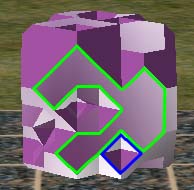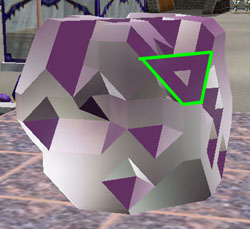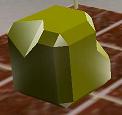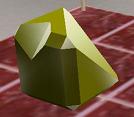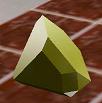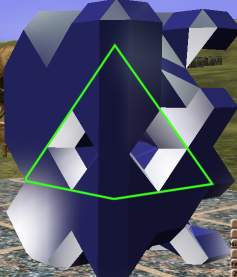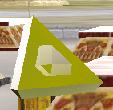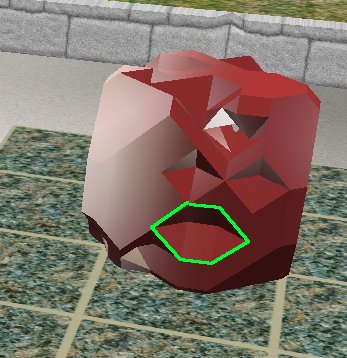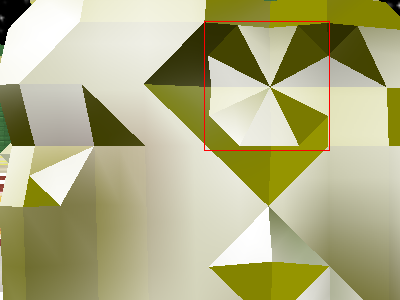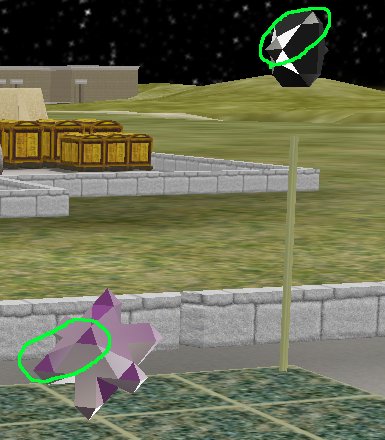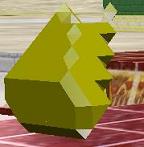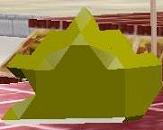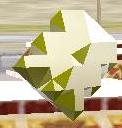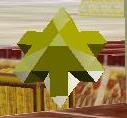- [Deutsch: Edelsteine Schleifen]?
- Franšaise: Taille de gemmes
Note: Uses listed in italics are based on Tale 2 information, and may change in Tale 3.
Cuttable Gems
Cuttable gems come in seven varieties (amethyst, garnet, lapis, turquoise, citrine, jade, and sunstone), and are acquired from water mines. Cuttable gems may be cut on a gem cutting table, slicing away sections of the stone until it matches a standard shape (see Gem Catalog, below). At this point, it may be saved to your inventory.
Nonstandard shapes may be saved in a Specimen Case -- a perk available to extended subscribers that holds one cut gem. The contents of a specimen case may later be loaded onto a table for additional cutting. Otherwise, a nonstandard gem that doesn't match a Gem Catalog entry must be discarded.
Different types of standard cut gems are used in the construction of various structures.
Understanding Gems
A cuttable gem is a three-dimensional matrix of vertices, 7x7x7. Each vertex may be present or absent. Facets form along the edges between present and absent vertices. Consider this gem:
The vertices on the outermost layer of the gem form a face, outlined in green. The outermost vertex at the point outlined in blue is missing, forming a divot in the gem. Holes like this are called "flaws" in the gem.
Each gem loaded into a cutting table will have a random set of flaws. Flaws always consist of a hole drilled straight into the gem from the outside in. You will never find a missing vertex deep within a gem that is not visible from the outside. Certain gems require flaws of a particular shape or location, so learning to use flaws is crucial to gemcutting.
I have been cutting many gems these past few days for opticons, and have found 3 gems now with hidden flaws inside them!!! Maybe I am going cross eyed from all the cutting, anyone else seen this? - rubenette
You were seeing flaws that came in from one of the other faces. - Tamutnefret
With the Fine Balance tech, a gem cutting table can be upgraded to show the weight of the gem being cut. The weight of a gem is equal to the number of solid vertices remaining.
Cutting Gems
Positioning the Camera
Start by loading a cuttable gem onto a gemcutting table. Pin the table's menu for reference; for best results, you may want to control the table using the hotkeys. (Remember: to use keyboard hotkeys, press enter to disable chat and then place the mouse over the building to control.)
Rotate the gem around to get a feel for the interface. It's easiest to view the table while using the Explorer's Camera (F6) or Builder's Camera (F7). Some players prefer to stand by the pole, with the camera rotated so it is on the rear right of the table. Others prefer the pole on the rear left, so the camera is looking at the face of the gem that will be sliced off by Disc 1.
Some players prefer to stand inside the table while cutting. To do this, run towards a point beyond the table, then right-click on empty ground to come to a halt.
Cutting the Gem
A gem may be cut using three sanding discs. Each disc will remove all the outermost vertices along a plane. Disc 1 removes the left side of the gem. Disc 2 removes the diagonal plane touching on the upper and front sides of the gem. Disc 3 removes the diagonal plane touching on the upper, front, and right sides of the gem.
The goal is to sand a gem into one of a number of predetermined shapes. You may find an example of one of these shapes by using the gem catalog, available on the gem cutting table. The gem catalog will display a sample gem atop the pole on the table. Use these samples for reference while cutting.
Most types of cut gem can only be formed by taking advantage of flaws in the gem. For example, the "eyelet" cut requires a flaw two vertices deep, surrounded by unflawed vertices. The "full eye" cut is harder, requiring a three-vertex flaw. Before sanding any facets off a gem, examine it carefully to see what kinds of cuts can be made from it. Remember that there is no way to drill holes into a gem--the sanding discs will only remove planes.
Sculptors sometimes say that they see the statue hidden within a block of stone, and cut away all that is not a part of it. This is exactly how gems are made: The desired cut gem is hidden within the rough stone. Sand away all the vertices that are not a part of it.
When you have produced an exact match for a cut gem, complete the cut by selecting the type of gem you are making from the "finished cutting" menu of the cutting table. If your gem is an exact, vertex-for-vertex match for the sample in the catalog, it will be removed from the table. You may need to rotate the gem to the same alignment as the one in the catalog.
Some gem cuts require flaws that are present in only a small fraction of rough gems. Zomboe, an expert gem cutter, provides this list of rare cuts: Tiki Mask is insanely rare. Others, in approximate order of decreasing rarity, are King's Tomb, Unity, Bridge, Lotus, Ring, Dragyn's Eye, Aidenn Mask. If you find a rough gem that can be cut into one of these, it's usually best to do it even if you're currently looking for something else -- you'll be glad of it later.
Gem Catalog
If you want to practice cutting gemcutting, Bijou tables offer a free way to hone your skills.
A short run of approximate rarities:
- All: practically all gems can be cut into this shape (90%+).
- Common: one in two gems can be cut into this shape.
- Uncommon: one in five gems can be cut into this shape.
- Rare: one in twelve gems can be cut into this shape.
- Ultra rare: one in thirty gems can be cut into this shape.
- Ultra rare+: insanely rare.
Aidenn Mask (15 carat)
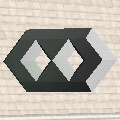 | Requirements: Two flaws next to each other. Rarity: Rare. |
- Use disc 1 to remove all the gem not in the same plane as the two flaws.
- Use disc 2 to cut around the flaws
Amanti (11 carat)
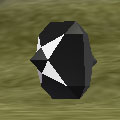 | Requirements: None. Rarity: All. |
- Use disc 1 to create a flat area on one face of the gem.
- Rotate this area onto the top of the gem.
- Use disc 2 to plane to the center of the flat area. Rotate the gem 90 degrees about the Z axis, and again plane to the center with disc 2. Rotate and plane two more times. The point produced should be recognizable as one half of an Amanti.
- Flip the gem upside down, and repeat the process to produce the other half.
Appolonia (21 carat)
 | Requirements: One flaw with a large area of unflawed gem on one side of it. Rarity: All. |
- Use disc 1 to remove all the gem not in the plane of the flaw
- Rotate the gem so that the flaw is at the top.
- Use disc 2 to make the top points on either side of the flaw
Bastet (11 carat)
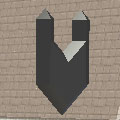 | Requirements: A flaw two vertices deep. Rarity: All. |
- Use disc 1 to remove all the gem not in the plane of the flaw
- Use disc 2 to make the point
Bridge (14 carat)
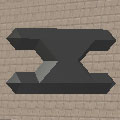 | Requirements: A pair of two vertex flaws directly opposite each other. Rarity: Ultra-Rare. Uses: Megalopolis (lapis) |
- Use disc 1 to remove all the gem not in the plane of the flaws
- Use disc 1 to make the points
Cat's Eye (28 carat)
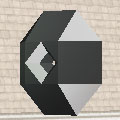 | Requirements: A two vertex deep flaw surrounded by a double ring of unflawed gem. Rarity: Rare. |
- Use disc 1 to create a flat area around the flaw.
- Rotate this area onto the bottom of the gem.
- Use disc 2 to plane all 4 sides of the gem.
- Use disc 3 to plane off the corners of the gem.
Choronzon (43 carat)
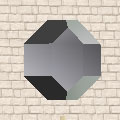 | Requirements: A block of unflawed gem measuring 5x5x3. Rarity: Common. Uses: research for Fine Balance (garnet); Megalopolis (turquoise) |
- Use disc 1 to make as large an unflawed plane as possible.
- Use disc 2 to make the side planes.
- Use disc 3 to make the ends.
Corner Heart (4 carat)
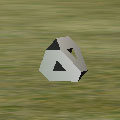 | Requirements: Very Small Unflawed Area. Rarity: All. Uses: Megalopolis (garnet) |
Find a "missing" corner - or make one with Disc 3. Turn the gem so that (if you have the demonstation pole at the back left of the table), the missing corner is at the front upper left. Use disc 3 to cut until the top edge meets. Spin the gem +Y, -Z. Repeat until finished. The "flaw" in the middle will appear when you make the final cut.
Another method is to look for the "flaw" on the outside of the gem. Look for an inverted letter 'A' and a number 9. Sometimes these same shapes will appear WITHOUT the "flaw"; that's the "missing" corner you're looking for as a starting point.
Use Disc 1 to remove the unwanted areas. No need to use the other discs. Although you may not be able to see the other flaws immediately, they are usually present once you've finished cutting the gems.
Dalessi (25 carat)
| Requirements: None. Rarity: All. |
This is much easier than it looks; you don't need a flaw for this cut, so most gems are suitable.
Using disc 1, cut a cube whose sides are 4 layers deep (if you get a perfect cube and have a Fine Balance, it should now be 64 carat). The cube does not have to be perfect at all; if it is not, one side is hopefully flawless - move this one to the bottom. Now cut with disc 3 until the side you are cutting aligns with the bottom corner. Rotate the gem 2 times on the Z axis, and cut with disc 3 again. Cut this side 2 more times than the opposite side, and you have a Dalessi cut.
Dragyn's Eye (17 carat)
| Requirements: 2 aligned flaws on adjacent faces. Rarity: Rare. Uses: Test of the Pathmaker (citrine) Future Uses: Chime Tower (amethyst), Megalopolis (lapis) |
The next condition to look for is to find a right triangle that surrounds each flaw. The long side of the triangle will touch the edge of the diamond shape of the flaw, the other two sides touch the remaining corners. This image shows a gem that was later successfully cut into a Dragyn's Eye. The green highlighted lines show the unflawed section that you need to cut out.
If both flaws have non-flawed triangles around them that join on one edge, then it is quite likely the cut will work.
- Use disc 1 to flatten the sides so your triangles are revealed (it is likely the gem starts this way and no sanding is necessary).
- Use disc 1 again to flatten the bottom so the triangles are sitting on a flat base.
- Rotate the gem so that the base is on the bottom and both triangles are facing away from disc 3. Use disc 3 until the Dragyn's Eye is complete.
Eyelet (16 carat)
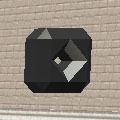 | Requirements: a flaw two vertex deep. Rarity: Common. Uses: Test of the Venery lockbox (garnet, amethyst, lapis, turquoise), Hackling Rake upgrade (2 matched gems), Megalopolis (amethyst) Future Uses: Charm of Flight, Reflect of Orbit, Automatic Loom |
The flaw can commonly be seen from outside the gem, without making a single cut. Otherwise you may be required to cut areas that have slightly bigger or slightly smaller flaws using disc 1.
- Using disc 1, cut all the "excess" parts around the flaw, creating a long "tube".
- Cut the side of the tube without the flaw till you reach the other side of the flaw.
Full Aidenn Mask (21 carat)
| Requirements: Parallel eyelet flaws (2-deep) with a 1-deep flaw between and below. Rarity: Ultra-Rare++ Uses: Megalopolis (Sunstone) |
to follow
Full Eye (24 carat)
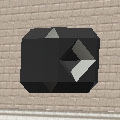 | Requirements: A three vertex deep flaw. Rarity: Rare. Uses: Flax Gin (turquoise) Future Uses: research for Ring Mechanics (amethyst) |
The flaw can commonly be seen from outside the gem, without making a single cut. Otherwise you may be required to cut areas that have slightly bigger or slightly smaller flaws using disc 1.
- Using disc 1, cut all the "excess" parts around the flaw, creating a long "tube".
- Cut the side of the tube without the flaw till you reach the other side of the flaw.
Hexas Plate (9 carat)
| Requirements: 1-vertex flaw. Rarity: All. Uses: Test of the Pathmaker (amethyst), Megalopolis (lapis) |
A very basic cut. For gems that lack the flaws needed for rarer cuts, find a flaw relatively close to an outside corner. Shave it off using disc 3 to create the inner "bowl". At this stage check to make sure the bowl cut is not flawed. If it is, seek a diamond flaw on another edge and start over. If not, trim down all the excess gem with disc 1, then finish up the final cuts with disc 3.
Hile's Chevrons (25 carat)
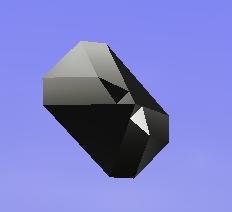 | Requirements: Unflawed plane. Rarity: All. Uses: Test of the Prismatic Opticon (sunstone) |
This cut is much easier than it might first appear.
First, trim a flat, unblemished plane on one side of the gem using Disc 1. Carve the long sides of the diagonal lozenge shape using Disc 2. Rotate on the X axis and slice away the short ends of the lozenge shape using Disc 2. Rotate on the Z axis so the vertical plane of the gem is facing away from Disc 2. Use Disc 3 to slice to the edge of the lozenge. Repeat for all four faces of the diagonal lozenge shape. The slices will meet in the center, creating the final gem cut.
Illustrations to follow.
Khufu's Ship (22 carat)
| Requirements: Double-width flaw one vertex deep, as seen below. Rarity: Uncommon. Future Uses: Lesser Sphinx (amethyst) |
To do this cut you need a double facet which is 1 thickness deep:
Flip the facet to the top, use disc 3 to take away the material right up to the edge of the facet on all 4 sides. Next use disc 1 to bring the sides in as far as needed. Flip the facet to the bottom and use disc 2 to form the "keel". Use disc 3 to finish off the front section and disc 2 to finish off the back.
King's Tomb (43 carat)
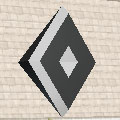 | Requirements: A single flaw surrounded by a double ring of unflawed gem. Rarity: Ultra-Rare++. Future Uses: Lesser Sphinx (amethyst) |
Although the flaw can be rarily seen without cutting the gem at all, many times cutting eyelet-like, double depth flaws will reveal that the inside flaw is indeed surrounded by unflawed space.
- Rotate the flaw to face either downward or toward you.
- Use disc three repeatedly to form the side of the pyramid (rotate once each side is complete).
Lens (12 carat)
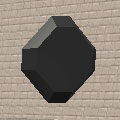 | Requirements: None. Rarity: All. Uses: Tower of the Racing Mind (amethyst), research for Fine Balance (garnet) Future Uses: Charm of Flight (garnet) |
- Use disc 1 to plane the gem down to a single flat layer with as few flaws as possible. #Rotate the gem to lie parallel to the table. #Use disc 3 to cut the corners.
Looking Glass (24 carat)
| Requirements: An unflawed area of gem measuring 6x4x1. Rarity: Common. Uses: Test of the Pathmaker, Test of the Megalopolis (jade) Future Uses: Ritual Voting Booth (amethyst) |
- Use disc 1 to remove all but a single plane of the gem
- Use disc 1 to make the the gem the correct size
Lotus (19 carat)
| Requirements: Specific pattern. Rarity: Ultra-Rare+. |
- Use disc 1 if necessary to expose the top flaw as in the pic.
- Rotate this area onto the top of the gem.
- Use disc 1 to plane to the edges of the flaw.
- Flip the gem upside down, and use disc 3 to make the point.
Queen's Tomb (18 carat)
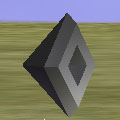 | Requirements: A single flaw surrounded by a ring of unflawed gem. Rarity: Common. Uses: Test of the Bijou (turquoise, amethyst), Gem Cutting Table upgrade (sunstone), research for Fine Balance (garnet) Future Uses: Set's Ladder |
Although the flaw can be rarily seen without cutting the gem at all, many times cutting eyelet-like, double depth flaws will reveal that the inside flaw is indeed surrounded by unflawed space.
- Rotate the flaw to face either downward or toward you.
- Use disc three repeatedly to form the side of the pyramid (rotate once each side is complete).
Ra's Lantern (27 carat)
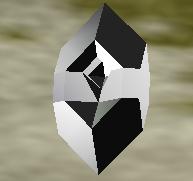 | Requirements: Double-width flaw with one flaw two vertices deep, located in the center of a gem's face; unflawed gem on remaining 3 sides of prism. Rarity: Ultra-Rare. Uses: Test of the Prismatic Opticon (sunstone) |
Ra's Lantern is just a taller version of the Symmetry cut, carved around a particular flaw. However, finding that flaw, centrally located, with unblemished gem on the other three sides is difficult. Approximate rarity is 1 in 40.
Locate a double-width flaw, one half of which penetrates two vertices into the gem. Using Disc 1, trim off the excess on the left and right sides. Rotate the gem on the Z axis, and trim the three vertical sides remaining so they are the same width as the flaw. At this point, you should have a rectangular block with the "mouth" of the lantern on the front, and three flawless flat faces on the remaining sides. Any flaw on the sides or back indicates an unsuitable gem.
To finish, rotate the gem around the Z axis, using Disc 3 to slice off each corner. This will create a sharp point at the top of the gem. Flip the gem over, and repeat for the bottom half. Illustrations to follow.
Reflection (14 carat)
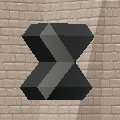 | Requirements: Two one-vertex flaws right next to each other, points touching. Rarity: Rare. |
The solid, hourglass-shaped area between the two flaws makes up the reflection cut.
- Disc 1 is all that is needed to do this cut. Flip the gem so that the two flaws are facing up and cut to the middle of the flaw on each side
Ring (13 carat)
Requirements: See Queen's Tomb.Rarity: Ultra-Rare.
Method:
If, while attempting a Queen's Tomb, you happen upon a hole through the pyramid, never fear: you have a Ring in the works. All you need to do is flip the top of the ring up and use disc 1 on shave off two of the corners on the top of the ring. Refer to the gem catalog to see which corners.
Sprocket (14 carat)
| Requirements: relatively unflawed diagonal plane Rarity: All. Uses: Megalopolis (sunstone) |
It's basically an Amanti cut taken apart and rearranged, you can see in the image below which part of the Amanti relates to which part of the Sprocket:
Sprocket Step by step:
- Cut with disc 2 until you get a nice and smooth side (picture 1)
- Rotate the gem 180 degrees around the X axis (+x +x), cut the opposite side with disc 2 to get a thickness of 1 layer (picture 2)
- Rotate once around the Z axis (+z), cut with disc 2 to get the characteristic seam (picture 3)
- Rotate back (-z), then once around the Y axis (-y), cut with disc 2 to complete one side of the Sprocket (picture 4)
- Flip the gem around (+x +x), cut with disc 2 until the seam is in the middle of the gem (picture 5)
- Rotate once around the Z axis (+z), cut with disc 2 to complete the Sprocket (picture 6)
Symmetry (19 carat)
| Requirements: An unflawed 3x3x3 cube. Rarity: All. Uses: Test of the Pathmaker (turquoise) |
- Use disc 1 to make a 3x3x3 cube. Missing corners are ok, but no other flaws.
- Use disc 3 to cut off each of the 8 corners.
Thistle (12 carat)
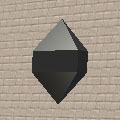 | Requirements: None. Rarity: All. Uses: research for Fine Balance (garnet), Megalopolis |
The thistle cut requires no flaws and a very small area of unflawed gem. Along with the lens and corner heart, this cut can be used to salvage cuts which go wrong. When nothing else works, thistle do ya!
- Use disc 2 to make a 2x2 tube
- Use disc three repeatedly to form the ends.
Thoth's Knot (18 carat)
| Requirements: 2 lines of 3 flaws, crossing adjacent to one another, with solid gem beside each and 1 cell of gem above and below. Rarity: Ultra-Rare++ Uses: None known. |
to follow
Tiki Mask (35 carat)
| Requirements: Double-width flaw one vertex deep, as seen below. Rarity: Ultra-rare++++. Uses: None known. |
This cut is rarest of the rare, only a handful have ever been cut. Very approximate rarity is 1 in 8000. This cut was designed by Zomboe and is the second new cut (after Sprocket, by Ashmael) to be added in ATITD2. It is based on a prototype cut still displayed in Zomboe's museum. Because it was so popular, Zomboe attempted to refine the cut, and the Tiki Mask was born. Pharaoh saw it and was impressed enough to add it to the catalog for a special contest: for one week, anyone to give a Tiki Mask to him received an Amethyst Lightbox in return. If you do happen to cut one, it is worth asking Pharaoh if the offer is still open though. Pharaoh said that the cut reminded him of quartz skulls, and considered naming it Skull (or similar), but he was outvoted by Zomboe's friends, who preferred Tiki Mask.
Some advice for cutting is that the cut is seven vertices tall, so the eyes must be on the centerline of the plane. Two eyelets close together is the simplest pattern to look for, but the cut can actually tolerate a much larger number of flaws.
Unity (36 carat)
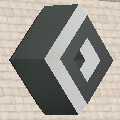 | Requirements: One flaw three vertices deep with a flawless area around it. Rarity: Ultra-rare+. Future Uses: Lesser Sphinx (amethyst), Megalopolis (lapis) |
An easy cut of extremely annoyingly difficult rarity. It requires a flaw that is a hole 3 thicknesses deep and has a completely flawless area 2 thicknesses deep all around it. It is cut by shaping a cube around the hole (1 sander) and using the 2 sander to make the diagonal edges.
Related Material
There's a Bijou School in Caldera Park, which is in northern Seven Lakes just to the southwest of the UThought (1236, 2228). The school includes all of the standard cuts, plus 6 competition Bijous and a regular Gem Cutting table. A Venery is used to provide commentary about how to acheive the various cuts and the source document is posted at Guilds/Sunset_Enterprises/Venery - Bijou School.
